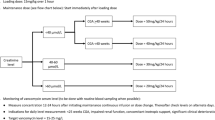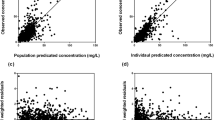Abstract
OBJECTIVE: There is no uniformity in the current recommendations of dosing regimen of gentamicin for neonates. We conducted a prospective, randomized, controlled trial to compare a once-daily dosing regimen to the twice-daily dosing regimen for neonates ≥2500 g during the first 7 days after birth.
STUDY DESIGN: Infants ≥2500 g admitted to the Neonatal Intensive Care Unit and prescribed gentamicin for suspected bacterial infection were randomized to receive either 4 mg/kg every 24 hours, study group (n=20), or a standard regimen of 2.5 mg/kg every 12 hours, control group (n=21). Serum gentamicin concentrations (SGCs) were followed and gentamicin pharmacokinetics calculated on all infants.
RESULTS: Peak SGC 30 minutes after the first dose was 8.2±1.7 μg/ml in the study group, compared to 6.4±1.5 μg/ml in the control group (p=0.001). Ninety-five percent of study group infants, compared to 81% of the control group, had peak SGCs in therapeutic range after the first dose. Peak SGC at 48 hours (steady state) was 8.9±1.5 in the study group and 6.8±1.1 in the control group (p=0.0001). On further analysis, a significantly higher percentage of infants in the study group, compared to the control group, had peak SGCs in higher therapeutic ranges of 6 to 12 μg/ml as well as 8 to 12μg/ml. None of the study infants, compared to six control infants, had trough SGCs ≥2 μg/ml at steady state. Thus, none of the study group infants, versus six of the control group infants, needed a dosing adjustment at 48 hours (p=0.02, Fisher's exact test).
CONCLUSION: We found that 4 mg/kg gentamicin given every 24 hours achieved significantly higher peak SGCs and safe trough concentrations in all infants, compared to the twice-daily regimen of 2.5 mg/kg. We suggest that SGCs may not need to be followed in term infants prescribed a short course of this once-daily regimen for suspected early-onset sepsis if renal functions are normal.
This is a preview of subscription content, access via your institution
Access options
Subscribe to this journal
Receive 12 print issues and online access
$259.00 per year
only $21.58 per issue
Buy this article
- Purchase on Springer Link
- Instant access to full article PDF
Prices may be subject to local taxes which are calculated during checkout


Similar content being viewed by others
References
Hickey SM, McCracken G Jr . Postnatal bacterial infections 6th ed. In: Fanaroff AA, Martin RJ, editors Neonatal Perinatal Medicine. Diseases of the Fetus and Infant St. Louis, MO, USA: Mosby 1997 p 713–31
American Academy of Pediatrics. In: Pickering LK, editor Red Book: Report of the Committee on Infectious Diseases 25th ed Elk Grove Village, IL, USA: American Academy of Pediatrics 2000 p 241–2
Papp CM, Nahata MC . Clinical pharmacokinetics of antibacterial drugs in neonates Clin Pharmacokinet 1990 19: 280–318
Moore RD, Smith CR, Lietman PS . The association of aminoglycoside plasma levels with mortality in patients with Gram-negative bacteremia J Infect Dis 1984 149: 443–8
Noone P, Pattison JR, Davies DG . The effective use of gentamicin in life threatening sepsis Postgrad Med J 1974 50: 9–16
Grasso S, Meinardi RD, De Carneri I, Tamassai V . New in vitro model to study the effect of antibiotic concentration and rate of elimination on antibacterial activity Antibact Agents Chemother 1978 13: 570–6
Prins JM, Buller HR, Kuiiper EJ, Tange RA, Speelman P . Once versus thrice daily gentamicin in patients with serious infections Lancet 1993 341: 335–9
Rozdzinski E, Kern WV, Reichle A et al. Once-daily versus thrice-daily dosing of netilmicin in combination of β-lactam antibiotics as empirical therapy for febrile neutropenic patients J Antimicrob Chemother 1993 31: 585–98
Barza M, Ioannidis JPA, Cappelleri JC, Lau J . Single or multiple daily doses of aminoglycosides: a meta-analysis Br Med J 1996 312: 338–45
Taketomo CK, Hodding JH, Kraus DM . Pediatric Dosage Handbook 6th ed Hudson, OH: Lexi-Comp 1999 p 421–4
Sieberry GK, Iannone R . The Harriet Lane Handbook, John Hopkins Hospital 15th ed St. Louis, MO, USA: Mosby 2000 p 728
Young TE, Mangum OB . Neofax, A Manual of Drugs used in Neonatal care 11th ed Raleigh, NC, USA: Acron Publishing 1998
Young TE, Mangum OB . Neofax, A Manual of Drugs Used in Neonatal care 8th ed Columbus, OH, USA: Ross Products Division, Abbott Laboratories 1995
Dubowitz LM, Dubowitz V, Goldberg C . Clinical assessment of gestational age in the newborn infants J Pediatr 1970 77: 1–10
Semchuk WM, Shevchuk YM, Sankaran K, Wallace SM . Prospective, randomized, controlled evaluation of a gentamicin loading dose in neonates Biol Neonat 1995 67: 13–20
Gal P, Ransom JL, Weaver RL . Gentamicin in neonates: the need for loading doses Am J Perinatol 1990 7: 254–7
McCracken GH Jr, Jones LG . Gentamicin in the neonatal period Am J Dis Child 1970 120: 524–33
Moore JD, Lietman PS, Smith CR . Clinical response to aminoglycoside therapy: importance of the ratio of peak concentration to minimal inhibitory concentration J Infect Dis 1987 155: 93–9
Dahl LB, Melby K, Guttenberg TJ, Storvold G . Serum levels of ampicillin and gentamicin in neonates of varying gestational age Eur J Pediatr 1986 145: 218–21
Hayani KC, Hatzopoulos FK, Frank AL et al. Pharmacokinetics of once-daily dosing of gentamicin in neonates J Pediatr 1997 131: 76–80
Thureen PJ, Reiter PD, Gresores A, Stolpman NM, Kawato K, Hall DM . Once-versus twice-daily gentamicin dosing in neonates ≥34 weeks' gestation: cost-effectiveness analyses Pediatrics 1999 103: 594–8
Skopnik H, Heimann G . Once daily aminoglycoside dosing in full term neonates Pediatr Infect Dis J 1995 14: 71–2
Lundergan FS, Glasscock GF, Kim EH, Cohen RS . Once daily gentamicin dosing in newborn infants Pediatrics 1999 103: 1228–34
Murphy JE, Austin ML, Frye RF . Evaluation of gentamicin pharmacokinetics and dosing protocols in 195 neonates Am J Health-Syst Pharm 1998 55: 2280–8
Vogelman B, Gudmundsson S, Turnidge J, Leggett J, Craig WA . In vivo postantibiotic effect in a thigh infection in neutropenic mice J Infect Dis 1988 157: 287–98
Acknowledgements
We are indebted to DF Kimball, PhD, and his staff from Department of Pathology for performing gentamicin concentrations, and the nursing and medical staff of the NICU, Cook County Hospital, for their assistance in data collection.
Author information
Authors and Affiliations
Additional information
Presented, in part, at the annual meeting of the Society for Pediatric Research, Boston, MA, May 2000.
Rights and permissions
About this article
Cite this article
Agarwal, G., Rastogi, A., Pyati, S. et al. Comparison of Once-Daily Versus Twice-Daily Gentamicin Dosing Regimens in Infants ≥2500 g. J Perinatol 22, 268–274 (2002). https://doi.org/10.1038/sj.jp.7210704
Published:
Issue Date:
DOI: https://doi.org/10.1038/sj.jp.7210704
This article is cited by
-
Neonatal sepsis: a systematic review of core outcomes from randomised clinical trials
Pediatric Research (2022)
-
Should gentamicin trough levels be routinely obtained in term neonates?
Journal of Perinatology (2016)
-
Pharmacokinetics and Pharmacodynamics of Antibacterials, Antifungals, and Antivirals Used Most Frequently in Neonates and Infants
Clinical Pharmacokinetics (2014)
-
Clinical pharmacokinetics of aminoglycosides in the neonate: a review
European Journal of Clinical Pharmacology (2009)
-
Pharmacological differences between once daily and twice daily gentamicin dosage in newborns with suspected sepsis
Pharmacy World & Science (2009)



